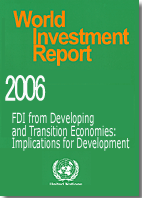|
Published by the United Nations Conference on Trade and Development - UNCTAD
WORLD INVESTMENT REPORT 2006
FDI from Developing and
Transition Economies: Implications for Development

This year´s World Investment Report focuses on the rise of
foreign direct investment (FDI) by transnational corporations (TNCs) from
developing and transition economies.
New sources of FDI are emerging among developing and transition economies.
This phenomenon has been particularly marked in the past ten years, and a
growing number of TNCs from these economies are emerging as major regional - or
sometimes even global - players. The new links these TNCs are forging with the
rest of the world will have far-reaching repercussions in shaping the global
economic landscape of the coming decades.
The Report examines the magnitude of this phenomenon and examines its drivers
and determinants, i.e.: what economic factors and policy developments lead firms
from developing countries to venture abroad? For low-income countries, FDI from
developing countries can be of great importance. In some of them, it accounts
for a significant share of all FDI flows. The Report also discusses the
development implications of the rise of these new sources of FDI, along with
policy responses, for both home and host developing countries.
As in previous years, the Report also presents the latest data on FDI and
traces the global and regional trends of FDI and international production by
TNCs. Global FDI inflows rose substantially in 2005. A major contributing factor
to this strong growth was the marked increase in the inflows to developed
countries. Rising global demand for commodities was reflected in the steep
increase in natural resource-related FDI, although the services sector continued
to be the major recipient of FDI. Among developing regions, Asia remained the
main magnet for FDI flows, followed by Latin America, where re-invested earnings
have played a major role. Africa´s share in world FDI inflows was still small,
but its FDI growth rate has nonetheless surpassed those of other developing
regions.
A substantial Statistical Annex is also included, with data
on FDI flows and stock for more than 200 economies. The PDF version of WIR05 and
the Statistical Annex are available in a CD-ROM.
METHODOLOGICAL NOTES: Definitions and
Sources. In addition to the general information on definitions
and sources provided in this year´s World Investment Report, more
detailed methodological notes for the data on FDI flows and stocks used in the
Report - including how they were obtained for each economy - are available in
electronic format only.
|
Preface,
Acknowledgements, Table of Contents, & Overview[PDF, 32pp.,
162KB]
Overview in
Chinese,
English,
French,
Spanish
Part One
ANOTHER YEAR OF FDI GROWTH
Chapter
I [PDF, 37pp., 765KB]
GLOBAL TRENDS: RISING FDI INFLOWS
A. Overall trends and developments in FDI
B. Policy development
C. The largest TNCs
Chapter
II [PDF, 63pp., 1232KB]
REGIONAL TRENDS: FDI GROWS IN MOST REGIONS
A. Developing Countries
B. South-East Europe and the Commonwealth on Independent States
C. Developed countries
Part Two
FDI FROM DEVELOPING AND TRANSITION ECONOMIES:
IMPLICATIONS FOR DEVELOPMENT
Introduction
and Chapter III [PDF, 37pp., 1208KB]
EMERGING SOURCES OF FDI
A. Developing and transition economies gain ground as home countries
B. Global and regional players emerging from developing and transition economies
C. Salient features of the emerging sources of FDI
Chapter
IV [PDF, 29pp., 374KB]
DRIVERS AND DETERMINANTS
A. Conceptual framework
B. Competitive advantages, drivers and motives
C. Conclusions
Chapter
V [PDF, 33pp., 552KB]
IMPACT ON HOME AND HOST DEVELOPING ECONOMIES
A. Impact on home economies
B. Impact on host economies
C. Conclusions
Chapter
VI [PDF, 46pp., 668KB]
NATIONAL AND INTERNATIONAL POLICIES
A. The role of home-country policies
B. Implications for host-country policies
C. International agreements and FDI from developing and transition economies
D. Corporate social responsibility and TNCs from developing and transition economies
E. Concluding remarks
Statistical Annex:
Annexes A and B and Definitions and Sources [PDF,
71pp., 375KB]
References
& Selected UNCTAD publications on Transnational
Corporations and Foreign Direct Investment [PDF,
20pp., 134KB]
Questionnaire [PDF,
2pp., 23KB]
METHODOLOGICAL NOTES:
Definitions and Sources
(Not contained in the hard-copy
version of the Report)
Methodological
Notes: [PDF, 83pp., 195KB]
Book information:
UN Symbol: UNCTAD/WIR/2006 & CD-ROM
Sales no.: E.06.II.D.11
Date of publication: 16/10/06
ISBN: 92-1-112703-3
No. of pages: 366
Price:
US$ 80 (Developed countries)
US$ 40 (Developing countries)
To order: Order
form
|
|
|